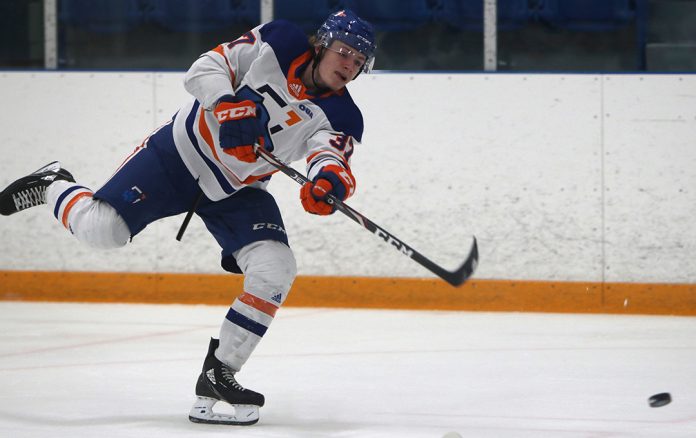Imagine you’re a major junior hockey player who has just finished your final year of eligibility and you are not taken in the National Hockey League Entry Draft. You now have a big decision to make: one that will shape your future.
You can either test your luck on lower-level pro leagues, if given the opportunity, and try to play your way to where you want to be or you can take the U SPORTS path and return to school.
The biggest difference between the two paths is that one relies solely on your on-ice ability to be able to make a living and the other puts a university degree in your back pocket.
U SPORTS hockey sometimes gets overlooked as a high-level league such as the Ontario Hockey League (OHL), Western Hockey League (WHL), and Quebec Major Junior Hockey League (QMJHL) because it consists of former junior players who didn’t go pro.
U SPORTS has improved rapidly in recent years, in terms of competitiveness.
Ontario Tech University’s men’s hockey head coach, Curtis Hodgins, has been coach of the team for five years and is his sixth year currently.
“I mean, the stigma is slowly starting to go away at the source level because people are now realizing just how good the hockey is and the talent level each year just continues to grow,” said Hodgins.
Most players played at a high level prior to starting their U SPORTS careers, except now they are growing and getting stronger, and faster as players.
Junior hockey consists of ages 16 to 21. Once a junior career is over and a player decides to play in U SPORTS, they become one of the younger players on the team.
University of Toronto head coach, Ryan Medal, also played U SPORTS hockey prior to becoming a coach.
“Junior hockey is a great development league and it’s really good hockey. But when you look at university hockey, it’s 21- to 25-year-old men playing,” said Medal. Players are no longer still teenagers and growing anymore, they’re adults playing other adults.
Cameron Hough, first-year player at Ontario Tech University where he is also studying Commerce, played both Major Junior and Junior A hockey before joining Ontario Tech.
“The main difference would be age, you know, you’re kind of back in that youngest guy position, usually when you start major junior you’re one of the youngest guys, there’s kids that’ll be four or five years older than you… and then when you go to university as a first year like I am you’re kind of back at the start again, there’s guys that are five or six years older,” said Hough.
James White is another first-year, commerce student playing on Ontario Tech.
With the age difference players have had more time to develop their skills, especially when practicing with older players.
“You have to make decisions more quickly and you don’t have as much time. Everyone’s so much older, right? You’re going from 16 to 20 to 21 to 26. Everyone just has those like five extra years,” said White.
U SPORTS Hockey in Ontario also takes a bit of a back seat to the abundance of other hockey leagues in the area, whether it be professional or junior.
In Ontario, there is an abundance of junior and professional leagues that are more centred in the hockey world.
“I think that, you know, at times like we definitely get lost in the shuffle. I mean Ontario, but especially in the GTA, you know, you have the Leafs, and then you have the Marlies… and then you have the CHL. There’s I think seven teams, maybe within an hour and a half of Toronto. So, you know, the CHL is a big part of that,” said Medal.
U SPORTS falls behind in exposure also. People will have heard more of the OHL teams in the area instead of the U SPORTS teams.
Other places in Canada don’t have this issue. The University of New Brunswick hockey team is on another level to locals over there. Head coach of the team, Gardiner MacDougall, has been with the program for 22 years.
“You know, like it has a really good reputation here and in the league is very competitive and, you know, a good attendance in most of the arenas… They come Friday night. We have 3500 people at the game where probably, you know, you guys would get a couple hundred for a U SPORTS game,” said University of New Brunswick head coach, MacDougall.
The hardest part of U SPORTS hockey comes off the ice. While these players are practising four to five times a week and playing two games every weekend, they are also full-time students in university.
“I think for any university hockey player you definitely have to have time management skills and it’s a balancing act. And you know, not only are you in class but, obviously you have a fair amount of work outside of class in terms of assignments and then, you know, preparing for midterms or finals or whatnot. But you’re still on the ice,” said Medal.
“So far I found it not bad actually which, you know, I’ve stayed on top of my work which is good so it hasn’t been too much of an issue but for me and a couple of the other guys in the business program, there are a couple classes that consume a lot of your time,” said Hough.
U SPORTS hockey is not just about being able to perform on the ice, you need to find a balance between playing at the top of your game, and staying on top of your studies.




